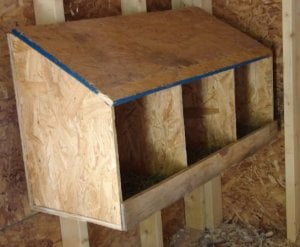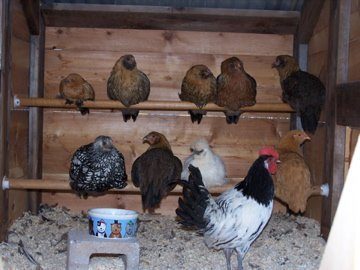My speaking engagement at the Craftcation Conference in Ventura this past weekend went well!
I attended some good workshops like making mozzarella cheese in half an hour and the history of the DIY movement. I met sewing celebrities Christine Haynes the author of Chic and Simple Sewing and Jenny Hart, the author of Sublime Stitching! There were lots of fun and crafty workshops, especially for the beginning seamstress.
In speaking to the attendees at my workshop, a lot of crafty types are getting into raising chickens right now.
Chickens are hip!
I think raising chickens, sewing, growing your own food and doing homemade crafts with your kids are all ways to live a more simple and crafty life.
So why am I blogging about chickens on a sewing blog?
Because I think you should try it!
Welcome to the second installment of my homespun living series, Chickens 101
Click here to read part one:
CHICKEN COOPS!
Getting your Coop Ready
Before you buy your chickens you need to have your coop in place.
As mentioned before chickens are social so plan on starting with at least two hens.
You can have a coop only and let your chickens pasture freely in your backyard
or have a coop with an attached and fenced run to protect your garden. Chickens can make a mess of the yard!
I let my chickens roam freely but I do have a fence around my vegetable garden.
You do need a yard to have chickens, even if only a very small one. They need dirt.
If you choose not to have a run, make sure you shut up your hens securely in their coop at night.Raccoons and coyotes and large owls strike even in urban environments!
You can convert an outbuilding in your yard or you can buy a small portable flowerless coop on wheels that can be moved around your yard called a chicken tractor.
Essentials for a chicken coop
The truth is people have been raising chickens for thousands of years without all of the requirements I am about descibe!
But if you want to avoid a stinky backyard and chicken disease this is good advice to take.
You will need a coop for sure and an attached run, and area where the chickens can roam outside that is fenced is good too.
You will need a coop for sure and an attached run, and area where the chickens can roam outside that is fenced is good too.
Proper Fencing and latched gates for your coop are essential and your run should also have one.
You can have normal gate fencing around your run but line the bottom with wire mesh to keep out snakes.
A well ventilated coop
Ammonia buildup and heat problems in the summer can be deadly in a hot, unventilated coop.
Mesh walls on three sides of the coop are ideal.
Choose strong wire mesh.
Predators can break through chicken wire!
You need plenty of light because the chickens' laying instinct is triggered by light so if your coop is very dark you might consider installing a lightbulb to turn on during the day.
But make sure your nesting boxes are in a darker part of your coop because although light triggers hens to lay they like a dark spot when they actually sit down to lay an egg.
Nesting boxes
You need nesting boxes for your hens to lay their eggs in.
3 hens can share one box.
You can buy nesting boxes at feed stores or you can improvise your own from old crates or even cardboard boxes.
You can build your own from lumber and can find lots of tutorials online.
Hens are birds and like to sleep on a perch.
Your roosting pole should be about 2 inches in diameter.
Don't use metal pole or PVC piping because chickens need a rough texture for their feet to grip on.
You can use.
- Wooden dowels
- 2 inch wide wooden Closet poles
- Tree branches
Place your poles about 2 feet off the ground or you can use a staggered ladder type perch so they are abocve and behind each other and each gets their own little perch.
I have an antique ladder with rounded rungs that I have propped against the wall.
Droppings tray.
Place an old board under the roosting poles.
Chickens poop a lot in their sleep and it will drop down
You can take the board out and scrape them into compost pile.
I recommend the deep litter method:
Here is how:
Start with a clean henhouse.
Throw about a 5 inch layer of straw or wood shavings on the floor.
If you have a run outside you can cover that with hay or shavings too. It will break down naturally and you wont need to remove it.
When you check the coop you can scoop out droppings with a small shovel.
Then rake the hay a little and add more hay or shavings on top weekly.
Once the bedding is about a foot high, remove it with a rake and replace it with new hay, about every few months.
Once a year in spring,remove all the bedding and scrub down your coop.
Don't forget to compost all the old bedding.
The rich nitrogen is very good for the compost.
Deep litter bedding keeps chickens warm in winter and the smells will be minimal with this method.
If you do smell a strong smell of ammonia you will know it is time to replace the bedding.
Pin It








You didn't leave anything out! Thank you for the detailed post!
ReplyDeleteI am going to contact my...um.. I dont know! Who do I contact to find out if I can have two or three hens in my backyard???
ReplyDeleteHi Brandi
ReplyDeleteYou need to call the animal control office for your county.
Cool series Justine! More people should definitely raise chickens :)
ReplyDeleteI just wanted you to know that this post couldn't have come at a BETTER time. I've been planning this for quite some time and can't wait for your next chicken post! Thanks.
ReplyDeleteWhat a great project! :) I've featured this post on Craft Gossip here:
ReplyDeletehttp://homeandgarden.craftgossip.com/build-your-on-chicken-coop/
If you would like a "featured by" button, you can grab one here:
http://homeandgarden.craftgossip.com/grab-a-craft-gossip-button/